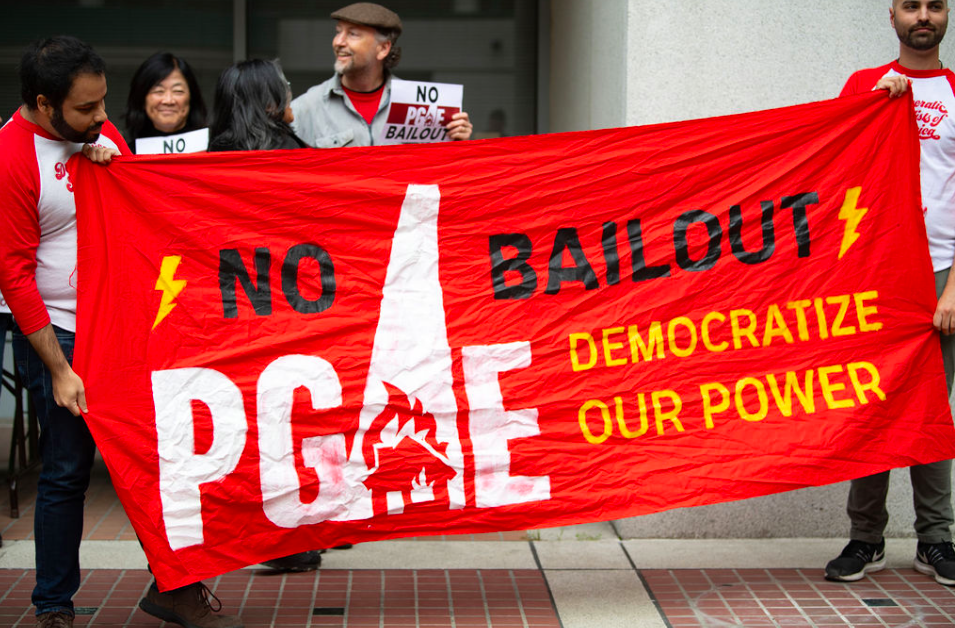People in San Francisco, and across Northern California, are paying increasingly high PG&E bills—for increasingly worse service. Most bills have gone up at least 20 percent in February, and will rise as much as another 20 percent later this year.
The California Public Utilities Commission says the ratepayers have to cough up more money to cover the cost of PG&E’s failures to keep its system maintained and the wildfires that the aging lines sparked.
We also have to pay to upgrade those lines now—something the company should have done a long time ago.

Meanwhile, SF residents are dealing with repeated power outages, some of which have nothing to do with storms, winds, or other weather. The company just can’t keep the lights on.
Yet PG&E is making huge profits.
The Board of Supes Land Use and Transportation Committee will hold a hearing Monday/26 on the power outages, and Sup. Myrna Melgar, who called for the hearing, has asked PG&E to respond.
There is, of course, a much larger issue here.
Most experts agree that one of the central ways the world can address climate change is to shift from fossil fuels to renewable electricity. That’s why we are seeing a push for electric cars, electric stoves, electric heating, all-electric homes and offices …. it’s really the only way we will have a future.
But that means we need a reliable, greatly expanded, and robust electric generation and delivery system—and it’s pretty clear that will never happen if private, profit-driven companies still control the electric grid.
Why should we, the people of Northern California, put up billions of dollars to improve PG&E’s infrastructure, which ought to be public? Can we really trust PG&E, which has lied and cheated repeatedly in the past, to use that money wisely? Why should our money pay for their system so they can make profits by selling us power at vastly inflated rates?
It makes no sense.
It particularly makes no sense in San Francisco, which is required by federal law to operate its own public power system. And there’s a statewide alternative already in place.
The nation will never be able to move to a fully electric system with the current utility structure. San Francisco, and California, could lead the way.
Perhaps that can be part of the discussion at LUT.
The Planning Commission hears a report Thursday/29 from its Affordable Housing Leadership Council, an appointed group that has the mandate to
provide recommendations to San Francisco City staff and policymakers on funding and financing and other strategies needed to deliver 46,000 housing units affordable at extremely low, very low, low, and moderate incomes as called for in the housing targets of the City’s recently adopted Housing Element.
The report, which you can read here, runs 132 pages. What is says, in essence, is that there’s no way the city will come anywhere close to the state mandates without a huge amount of new federal and state money—which right now doesn’t exist.
Some excerpts:
Federal and State funding together are the largest funding sources for affordable housing, providing around two thirds of the funding to build new 100% affordable housing. Available federal and state funding, however, has fallen far short of need. It is unlikely San Francisco can come close to meeting its housing goals without more Federal, state, and regional funding. For this reason, the Leadership Council has focused a number of recommendations on expanding funding and shifting policy at the Federal, State, Regional levels. San Francisco’s elected officials, advocates, and City staff will need to work with affordable housing and community development stakeholders from other cities, the state, and in Washington DC to win needed affordable housing resources and other policy changes.
The report notes that San Francisco has already done lots of upzoning, constraint reduction, and everything else that would make it easier to build housing. But:
Yet even with this progress, like nearly all cities in California, San Francisco has struggled to meet its affordable housing goals because there is no funding attached to the RHNA goals. From 2015-2022, San Francisco’s RHNA called for over 16,000 units affordable at very low, low and moderate incomes as well as 12,500 units affordable at above moderate incomes. During that timeframe, San Francisco produced 9,517 affordable units, or 58% of its goal for housing affordable low and moderate incomes. San Francisco would need to nearly triple housing production across all income levels to meet the ambitious RHNA goals for 2023-2030, yet funding has not increased to support this production. In order for the City to achieve its housing goals across income levels, city agencies have been tasked with removing barriers to housing development through process improvements to streamline housing approvals and permits as directed by the Mayor’s Housing for All Executive Directive. Given the need for subsidy for housing affordable at lower incomes, the City cannot meet its affordable housing targets without a dramatic increase in state, federal, local, and private investments as well as other changes recommended in this report.
This is a savage an indictment of the approach the state, led by our own Sen. Scott Wiener, has pushed on San Francisco. I will repeat:
San Francisco has struggled to meet its affordable housing goals because there is no funding attached to the RHNA goals.
The market-driven approach is failing. Nobody sees any way to meet the RHNA goals. The Planning Commission will hear this, and file it away, but the reality will remain:
Why isn’t Rep. Nancy Pelosi, who is still one of the most powerful people in DC, sending money to California and San Francisco for affordable housing? Why isn’t Gavin Newsom sending money to cities for affordable housing?
Why isn’t Mayor London Breed saying all of this in public?
Why is San Francisco stuck with a mandate to provide a public good that nobody else at any level wants to pay for?
The hearing starts at noon.



